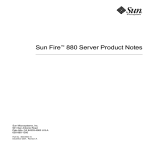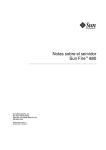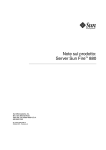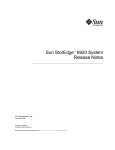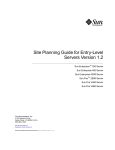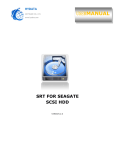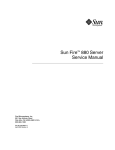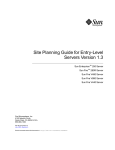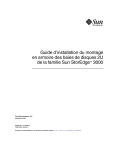Download Seagate ST336704FC Owner`s manual
Transcript
Sun Fire™ 880 Server Product Notes Sun Microsystems, Inc. 901 San Antonio Road Palo Alto, CA 94303-4900 U.S.A. 650-960-1300 Part No. 806-6593-18 June 2003, Revision A Copyright 2003 Sun Microsystems, Inc., 901 San Antonio Road, Palo Alto, CA 94303-4900 U.S.A. All rights reserved. This product or document is distributed under licenses restricting its use, copying, distribution, and decompilation. No part of this product or document may be reproduced in any form by any means without prior written authorization of Sun and its licensors, if any. Third-party software, including font technology, is copyrighted and licensed from Sun suppliers. Parts of the product may be derived from Berkeley BSD systems, licensed from the University of California. UNIX is a registered trademark in the U.S. and other countries, exclusively licensed through X/Open Company, Ltd. Sun, Sun Microsystems, the Sun logo, AnswerBook, AnswerBook2, docs.sun.com, Sun Enterprise, OpenBoot, SunSwift, SunVTS, JumpStart, SunSolve Online, and Solaris are trademarks, registered trademarks, or service marks of Sun Microsystems, Inc. in the U.S. and other countries. All SPARC trademarks are used under license and are trademarks or registered trademarks of SPARC International, Inc. in the U.S. and other countries. Products bearing SPARC trademarks are based upon an architecture developed by Sun Microsystems, Inc. The OPEN LOOK and Sun™ Graphical User Interface was developed by Sun Microsystems, Inc. for its users and licensees. Sun acknowledges the pioneering efforts of Xerox in researching and developing the concept of visual or graphical user interfaces for the computer industry. Sun holds a non-exclusive license from Xerox to the Xerox Graphical User Interface, which license also covers Sun’s licensees who implement OPEN LOOK GUIs and otherwise comply with Sun’s written license agreements. Federal Acquisitions: Commercial Software—Government Users Subject to Standard License Terms and Conditions. DOCUMENTATION IS PROVIDED “AS IS” AND ALL EXPRESS OR IMPLIED CONDITIONS, REPRESENTATIONS AND WARRANTIES, INCLUDING ANY IMPLIED WARRANTY OF MERCHANTABILITY, FITNESS FOR A PARTICULAR PURPOSE OR NON-INFRINGEMENT, ARE DISCLAIMED, EXCEPT TO THE EXTENT THAT SUCH DISCLAIMERS ARE HELD TO BE LEGALLY INVALID. Copyright 2003 Sun Microsystems, Inc., 901 San Antonio Road, Palo Alto, CA 94303-4900 Etats-Unis. Tous droits réservés. Ce produit ou document est distribué avec des licences qui en restreignent l’utilisation, la copie, la distribution, et la décompilation. Aucune partie de ce produit ou document ne peut être reproduite sous aucune forme, par quelque moyen que ce soit, sans l’autorisation préalable et écrite de Sun et de ses bailleurs de licence, s’il y en a. Le logiciel détenu par des tiers, et qui comprend la technologie relative aux polices de caractères, est protégé par un copyright et licencié par des fournisseurs de Sun. Des parties de ce produit pourront être dérivées des systèmes Berkeley BSD licenciés par l’Université de Californie. UNIX est une marque déposée aux Etats-Unis et dans d’autres pays et licenciée exclusivement par X/Open Company, Ltd. Sun, Sun Microsystems, le logo Sun, AnswerBook, AnswerBook2, docs.sun.com, Sun Enterprise, OpenBoot, SunSwift, SunVTS, JumpStart, SunSolve Online, et Solaris sont des marques de fabrique ou des marques déposées, ou marques de service, de Sun Microsystems, Inc. aux EtatsUnis et dans d’autres pays. Toutes les marques SPARC sont utilisées sous licence et sont des marques de fabrique ou des marques déposées de SPARC International, Inc. aux Etats-Unis et dans d’autres pays. Les produits portant les marques SPARC sont basés sur une architecture développée par Sun Microsystems, Inc. L’interface d’utilisation graphique OPEN LOOK et Sun™ a été développée par Sun Microsystems, Inc. pour ses utilisateurs et licenciés. Sun reconnaît les efforts de pionniers de Xerox pour la recherche et le développement du concept des interfaces d’utilisation visuelle ou graphique pour l’industrie de l’informatique. Sun détient une licence non exclusive de Xerox sur l’interface d’utilisation graphique Xerox, cette licence couvrant également les licenciés de Sun qui mettent en place l’interface d’utilisation graphique OPEN LOOK et qui en outre se conforment aux licences écrites de Sun. LA DOCUMENTATION EST FOURNIE “EN L’ETAT” ET TOUTES AUTRES CONDITIONS, DECLARATIONS ET GARANTIES EXPRESSES OU TACITES SONT FORMELLEMENT EXCLUES, DANS LA MESURE AUTORISEE PAR LA LOI APPLICABLE, Y COMPRIS NOTAMMENT TOUTE GARANTIE IMPLICITE RELATIVE A LA QUALITE MARCHANDE, A L’APTITUDE A UNE UTILISATION PARTICULIERE OU A L’ABSENCE DE CONTREFAÇON. Please Recycle Contents Product Name Equivalence Document Revision History 1 1 Available Online Documentation 3 Software and OpenBoot Firmware Requirements CPU/Memory Board Hardware Requirements CPU/Memory Board Speeds DIMMs 3 5 5 5 Required And Recommended Software Patches Required Software Patches for Solaris 9 6 Required Software Patches for Solaris 8 7 Highly Recommended Sun Fire 880 Patch Sun PCI Cards That Support PCI Hot-Plug 6 8 8 Caution on the Use of PCI Cards Not Specifically Qualified by Sun on the Sun Fire 880 Platform 10 OpenBoot Firmware Documentation FC-AL Disk Drive Firmware Issues 10 11 Installing Sun Fire 880 FC-AL Backplane Firmware System Hang Recovery Procedure 12 14 Updated Rackmounting Information for the Sun Fire 880 Server Sun Fire 880 Server Rackmounting Caution Reminder 17 17 Contents iii Documentation Errata 18 Clarification to Independent Memory Subsystem Information Correction to the Motherboard Fan Tray Removal Procedure 18 18 Correction to the Motherboard Fan Tray Installation Procedure Correction to Disk Drive Installation Procedure 20 Correction to FC-AL Disk Cage Installation Procedure Correction to FRU Part Numbers Ordering DIMMs 19 20 20 20 Part Number Corrections 20 Correction to Cabling Instructions for Loop B PCI FC-AL Data Cable Correction to Expansion FC-AL Backplane Installation Procedure Correction to Displaying POST Results 21 22 23 Correction to the obdiag-trigger and post-trigger Setting for Enabling ASR 23 obdiag-trigger and post-trigger setting diag-level setting and ASR Fully Enabling ASR 23 24 24 Correct Usage of the ifconfig Command for PCI Hot-Plug Correction to the Attachment Point IDs for DR Procedures Open Issues 25 25 26 PCI attachment points should be generic (BugID 4388625) 26 prtfru on shows incorrect DIMM slot information/mapping (BugID 4616050 and 4810058) 27 picld process spending too much of CPU time cumulatively (BugID 4661192) 27 psvcplugin segmentation fault during picld stop (BugID 4796100) iv Sun Fire 880 Server Product Notes • June 2003 27 Sun Fire 880 Server Product Notes Product Name Equivalence The official released name for this system is Sun Fire™ V880. Any reference to Sun Fire 880 on the product, in the system documentation, or in software refers to the Sun Fire V880. Both names can be considered equivalent and are interchangeable. Document Revision History This section provides a summarized revision history of these Product Notes, listed according to the document revision number and release date. All the updates made in previous revisions are incorporated into the latest revision; that is, any updates made in the -13 revision will carry forward through any subsequent revisions. The first published version of this document is 806-6598-12, September 2001. Revisions Made in 806-6593-18, May 2003 ■ Revised “Software and OpenBoot Firmware Requirements” on page 3 ■ Revised “CPU/Memory Board Hardware Requirements” on page 5 ■ Updated “Required And Recommended Software Patches” on page 6 ■ Added “Clarification to Independent Memory Subsystem Information” on page 18 ■ Revised “Updated Rackmounting Information for the Sun Fire 880 Server” on page 17 ■ Updated “Correction to the obdiag-trigger and post-trigger Setting for Enabling ASR” on page 23 ■ Added “Fully Enabling ASR” on page 24 ■ Updated “Documentation Errata” on page 18 and “Open Issues” on page 26 1 Revisions Made in 806-6593-17, April 2002 (806-6598-16 is not used) ■ Updated “Required And Recommended Software Patches” on page 6 ■ Revised “Updated Rackmounting Information for the Sun Fire 880 Server” on page 17 ■ Added “Caution on the Use of PCI Cards Not Specifically Qualified by Sun on the Sun Fire 880 Platform” on page 10 ■ Revised “Installing Sun Fire 880 FC-AL Backplane Firmware” on page 12 ■ Updated “Documentation Errata” on page 18 and “Open Issues” on page 26 Revisions Made in 806-6593-15, December 2001 ■ Updated the list of “Required And Recommended Software Patches” on page 6 ■ Added “Updated Rackmounting Information for the Sun Fire 880 Server” on page 17 ■ Added “Sun Fire 880 Server Rackmounting Caution Reminder” on page 17 ■ Added “Correction to Displaying POST Results” on page 23 ■ Added “Correction to the obdiag-trigger and post-trigger Setting for Enabling ASR” on page 23 ■ Added “Correct Usage of the ifconfig Command for PCI Hot-Plug” on page 25 ■ Added “Correction to the Attachment Point IDs for DR Procedures” on page 25 ■ Added “PCI Hot-plug insert message is wrong for slots 7 and 8 (BugID 4546219)” on page 33 ■ Added “PCI attachment points should be generic (BugID 4388625)” on page 26 ■ Added “System generates picld error message after reboot (BugID 4487110)” on page 35 Revisions Made in 806-6593-14, October 2001 ■ Updated the list of “Required And Recommended Software Patches” on page 6 ■ Added keyswitch information to “Installing Sun Fire 880 FC-AL Backplane Firmware” on page 12 ■ Added “System Hang Recovery Procedure” on page 14 ■ Added “CE memory reporting is ambiguous (BugID 4491362)” on page 32 Revisions Made in 806-6593-13, October 2001 ■ 2 Updated the list of “Required And Recommended Software Patches” on page 6 Sun Fire 880 Server Product Notes • June 2003 Revisions Made in 806-6593-13, October 2001 ■ Updated the list of “Sun PCI Cards That Support PCI Hot-Plug” on page 8 ■ Corrected and updated the 36 GB drive manufacturer numbers in “FC-AL Disk Drive Firmware Issues” on page 11 ■ Updated the FRU numbers for ordering DIMMs for the system in “Correction to FRU Part Numbers” on page 20 Available Online Documentation A complete set of online documentation supporting Sun Fire 880 servers is available at the following URLs: http://www.sun.com/products-n-solutions/hardware/docs http://docs.sun.com Check these sites periodically for the latest revisions of Sun Fire 880 product documentation, including the latest version of these Product Notes. Software and OpenBoot Firmware Requirements The following table lists the minimum Solaris operating environment and OpenBoot™ PROM firmware requirements for Sun Fire 880 systems, according to the speed of the CPU/Memory boards installed on a Sun Fire 880 server. CPU/Memory board speed Minimum required Solaris operating environment Minimum required OpenBoot firmware level* 750 MHz Solaris 8 7/01* OpenBoot Firmware 4.2.9 900 MHz Solaris 8 10/01* OpenBoot Firmware 4.5.12 1050 MHz Solaris 8 10/01* OpenBoot Firmware 4.7.5 * or a compatible version Sun Fire 880 Server Product Notes 3 Note – If you are upgrading a Sun Fire 880 server using 750 MHz CPU/Memory boards to 900 MHz or 1050 MHz CPU Memory boards, you must update the system OpenBoot firmware with patch 112186-09 or later before you install the new CPU/Memory boards. For more information about the patch, including installation instructions, read the patch description. For information about obtaining the patch, see “Required And Recommended Software Patches” on page 6. To verify that the proper version of the operating environment is installed on the Sun Fire 880 server, examine the /etc/release file. This file should contain the text “Solaris X X/XX” or identify a subsequent compatible Solaris release. To determine the current OpenBoot firmware version on a system, use one of the following methods. While the Solaris operating environment is running, type the following command: # /usr/sbin/prtconf -V Or, From the ok prompt, type the following command: ok .version For more information about obtaining and installing OpenBoot firmware, see “Required And Recommended Software Patches” on page 6. 4 Sun Fire 880 Server Product Notes • June 2003 CPU/Memory Board Hardware Requirements The following table lists the CPU/Memory board part numbers for the Sun Fire 880 server. CPU/Memory board Part number 750 MHz 501-5818 501-6360 900 MHz 501-6334 501-6676 1050 MHz 501-6677 501-7706 CPU/Memory Board Speeds A Sun Fire 880 server must use CPU/Memory boards of the same speed within a system. For example, you can not run 750 MHz CPU/Memory boards and 900 MHz CPU/Memory boards installed in the same Sun Fire 880 system. DIMMs It is required that you populate each DIMM slot on a 1050 MHz CPU/Memory board in a Sun Fire 880 server. For lower speed CPU/Memory boards, it is recommended that you populate each DIMM slot. For more information about DIMMs, including information about memory interleaving, see the Sun Fire 880 Server Owner’s Manual. 1GByte memory modules are not supported in 750 MHz CPU/Memory board modules Sun Fire 880 Server Product Notes 5 Required And Recommended Software Patches This section lists software patches for the Sun Fire 880 server. You can obtain these patches from your authorized Sun service provider or by downloading them from the SunSolve OnlineSM web site at the following URL: http://sunsolve.sun.com The patches in these Product Notes are listed by the Solaris operating system version you may have installed on your system. For the most current list of Sun Fire 880 patches, search for the Info Doc “Highly Recommended Patches Sun Fire 880” on the SunSolve Online web site. For patch installation instructions, see the README file that accompanies each patch. Required Software Patches for Solaris 9 Note – The following list represents required patches specific to the Sun Fire 880 system with the Solaris 9 09/02 operating system installed. These patches are available as of the publication date of these Product Notes. Sun Fire 880 Required Patches for Solaris 9 Patch ID 6 Description 109962-10 or later FC-AL Disk Drive Firmware patch 111649-03 or later Hardware/DVD: Toshiba DVD 1401 firmware (1009) 111847-07 or later SAN Foundation Kit patch (MPxIO/leadville)* 112233-05 or later SunOS 5.9: Kernel update patch 112902-12 or later SunOS 5.9: /kernel/drv/ip patch 112965-01 or later SunOS 5.9: /kernel/drv/sparc9/eri patch 113039-03 or later SunOS 5.9: Sun StorEdge Traffic manager patch* 113040-05 or later SunOS 5.9: fctl/fp/fcp/usoc driver patch* 113041-03 or later SunOS 5.9: fcip driver patch* 113042-04 or later SunOS 5.9: qlc driver patch* 113043-04 or later SunOS 5.9: luxadm, liba5k and libg_fc patch* 113044-03 or later configadm patch* 113068-04 or later SunOS 5.9: hpc3130 patch 113218-08 or later Schizo driver patch Sun Fire 880 Server Product Notes • June 2003 Sun Fire 880 Required Patches for Solaris 9 Patch ID Description 113312-01 or later Hardware/DPM: Sun Fire V880 Fibre-Channel Backplane Firmware (9228) 113361-02 or later SunOS 5.9: Sun Gigabit Ethernet 3.0 patch 113388-02 or later RSC 2.2.1 patch 113573-01 or later SunOS 5.9: libpsvc patch 113574-02 or later SunOS 5.9: SUNW, Sun-Fire-880 libpsvc Patch * Patches 111847, 113039, 113040, 113041, 113042, 113043 and 113044, require the package SUNWsan (San Foundation Kit). The SUNWsan package is available via the Sun Download Center at the following URL: http://www.sun.com/storage/san/ From that site, download the latest SAN release Software/Firmware upgrade. Required Software Patches for Solaris 8 Note – The following list represents required patches specific to the Sun Fire 880 system with the Solaris 8 07/01, Solaris 8 10/01, and Solaris 8 02/02 operating systems. These patches are available as of the publication date of these Product Notes. Sun Fire 880 Required Patches for Solaris 8 Patch ID Description 108528-20 or later Kernel update patch 108813-12 or later GEM patch 109882-06 or later SunOS 5.8: eri header files patch 109888-25 or later SunOS 5.8: Platform drivers patch 109962-04 or later FC-AL Disk Drive Firmware patch 110460-28 or later SunOS 5.8: fruid/PICL plug-ins patch 110723-05 or later SunOS 5.8: /kernel/drv/sparcv9/eri patch 110842-10 or later SunOS 5.8: hpc3130 driver patch for SUNW, Sun Fire 880 110849-12 or later SunOS 5.8: PICL support for SUNW, Sun Fire 880* 111095-13 or later SunOS 5.8: fctl/fp/fcp/usoc driver patch* 111096-06 or later SunOS 5.8: fcip driver patch* 111097-12 or later SunOS 5.8: qlc driver patch* 111412-11 or later SunOS 5.8: mpxio/scsi_vhci multipath I/O modules patch* 111413-0 or later SunOS 5.8: luxadm, liba5k and libg_fc patch* Sun Fire 880 Server Product Notes 7 Sun Fire 880 Required Patches for Solaris 8 Patch ID Description 111474-06 or later Sun Fire 880 Fibre-Channel Backplane Firmware patch 111500-09 or later RSC 2.2 patch 111649-03 or later Hardware/DVD: Toshiba DVD 1401 firmware (1009) 111846-06 or later SunOS 5.8: cfgadm fp plug-in library patch* 111847-07 or later SAN foundation kit patch* * Patches 110849, 111095, 111096, 111097, 111412, 111413 and 111846 require the package SUNWsan (San Foundation Kit). The SUNWsan package is available via the Sun Download Center at the following URL: http://www.sun.com/storage/san/ From that site, download the latest SAN release Software/Firmware upgrade. Highly Recommended Sun Fire 880 Patch Patch ID Description 112186-09 or later Sun Fire 880 Flash PROM Update (4.10.01 OBP) This patch is not OS-dependant. Included in this firmware upgrade are enhanced OpenBoot™ tools for service providers. The patch is required for Sun Fire 880 systems using 900 MHz CPU/Memory boards and 1050 MHz CPU/Memory boards. The patch is recommended for Sun Fire 880 systems that have installed versions of OBP earlier than 4.5.6. For specific CPU/Memory board OpenBoot firmware requirements, see “Software and OpenBoot Firmware Requirements” on page 3. For more information about the patch, including installation instructions, read the patch description. Sun PCI Cards That Support PCI Hot-Plug For a PCI card to be successfully detached from a running operating environment, each device on the card must have a detach-safe driver. A detach-safe driver enables a single instance of a driver to be closed while other instances are allowed to remain open to service similar devices used elsewhere in the system. To be considered detach-safe, a driver must be able to perform a basic Device Driver Interface/Device Kernel Interface (DDI/DKI) function called DDI_DETACH. Any driver that does not support the DDI_DETACH function is considered detach-unsafe. 8 Sun Fire 880 Server Product Notes • June 2003 Sun Microsystems offers a variety of hot-pluggable PCI cards that use detach-safe device drivers. The following table lists the PCI cards that have been tested and verified as being detach-safe as of the publication date of this document. Sun Part Number Card Type Driver(s) X1032A 10/100BaseT Sun FastEthernet + SE Ultra/Wide SCSI fas/sd, hme X1033A 10/100BaseT Sun FastEthernet PCI Adapter hme X6540A Dual Channel Single-ended Ultra/Wide SCSI glm X6541A Dual Channel Differential Ultra/Wide SCSI glm X6727A Sun StorEdge PCI Dual Fibre Channel Network Adapter* qlc X6799A Sun StorEdge PCI Single Fibre Channel Network Adapter qlc X1034A Quad FastEthernet PCI Card qfe X1150A Sun GigaSwift Ethernet Network Interface Card ce Note – *The Sun StorEdge PCI Dual Fibre Channel Network Adapter in the Sun Fire 880 systems requires the Solaris 8 10/01 or 8 02/02 operating environment or a compatible Solaris version. Note – Many third-party drivers (those purchased from vendors other than Sun Microsystems) do not support the DDI_DETACH function. Verify any third-party PCI card functionality and hot-plug compatibility with the third-party card’s vendor prior to use in a production environment. Note – Always wait for a PCI hot-plug operation to complete before initiating a new operation. For more information about Sun Fire 880 PCI hot-plug operations, refer to the Sun Fire 880 Dynamic Reconfiguration Guide (816-1465-10). This online document is available on the Solaris on Sun Hardware AnswerBook, which is provided on the Computer Systems Supplement CD for your specific Solaris release. For an updated list of Sun PCI cards that support PCI hot-plug operations, see the latest revision of these Product Notes, available at the following URL: http://www.sun.com/products-n-solutions/hardware/docs Sun Fire 880 Server Product Notes 9 Caution on the Use of PCI Cards Not Specifically Qualified by Sun on the Sun Fire 880 Platform In order to ensure robust system operation, it is extremely important to ensure that any PCI cards and associated drivers installed in a Sun Fire 880 system have been qualified by Sun for use on the platform. It is possible for interactions to occur between cards and drivers on a specific bus that can lead to potential system panics or other negative outcomes if the card/driver solution has not been qualified. For an updated list of qualified PCI cards and configurations for the Sun Fire 880 system, contact your Sun authorized sales representative or service provider. For additional information, refer to the following URL: http://www.sun.com/io OpenBoot Firmware Documentation The Sun Fire 880 server uses OpenBoot™ 4.x system firmware. Instructions for using the firmware are provided in the OpenBoot 4.x Command Reference Manual, an online version of which is included with the OpenBoot Collection AnswerBook that ships with Solaris software. Note – Some versions of Solaris software do not include the OpenBoot 4.x documentation. If the OpenBoot 4.x documentation is not provided with your specific version of Solaris software, you can access the documentation online at http://docs.sun.com 10 Sun Fire 880 Server Product Notes • June 2003 FC-AL Disk Drive Firmware Issues All FC-AL disk drives installed in a Sun Fire 880 system must meet the minimum firmware revision levels for Sun Fire 880 systems. Incorrect firmware can cause a variety of system problems that are often difficult to diagnose. To determine a disk drive’s firmware revision level, use the inquiry feature of the Solaris format(1M) utility. The following table shows the minimum firmware revision levels for Sun Fire 880 disk drives as of the publication date of this document. Sun Part No. Capacity Manufacturer Minimum Firmware Revision Level 540-4525 36 GB Seagate ST336605FC Seagate ST336607FC Seagate ST336704FC 0538 038 0826 540-4905 540-5408 72 GB Seagate ST373307FC Seagate ST373405FC Seagate ST373405FC MAN3735FC MAP3735FC DU32EJ-72FC 0538 0538 0538 0538 0538 0538 Note – Drive capacities lower than 36 Gbytes are not supported on the Sun Fire 880. For the most current list of Sun Fire 880 supported disk drives, see the latest revision of these Product Notes, available at the following URL: http://www.sun.com/products-n-solutions/hardware/docs Note – All Sun Fire 880 disk drives that are installed at the factory, shipped as customer-installable options, or installed as field-replaceable units (FRUs) meet the minimum firmware revision levels. Sun Fire 880 Server Product Notes 11 Installing Sun Fire 880 FC-AL Backplane Firmware A backup image of the Sun Fire 880 FC-AL backplane firmware is provided on the Computer Systems Supplement CD for your specific Solaris release. In the unlikely event that the firmware on a Sun Fire 880 FC-AL backplane becomes corrupted, you can use the backup image to flash update the backplane with its original firmware. The flash update procedure is performed with the Solaris luxadm utility and is described below. Before you can flash update the backplane, the firmware image must be copied from the Supplement CD to the Sun Fire 880 system disk. If you use Solaris Web Start to install the Supplement CD software, the Sun Fire 880 FC-AL Backplane Firmware is not included in the default installation. To install the backup firmware on the system disk, choose the Custom Install option and select the Sun Fire 880 FC-AL Backplane Firmware. For more information, see “Installing Supplement CD Software” in the Solaris on Sun Hardware Platform Guide. Note – The latest version of the backplane firmware is always available on the SunSolve Online web site at sunsolve.sun.com. Whenever possible, you should download and install the firmware from the SunSolve site instead of the Supplement CD. The firmware on the Supplement CD is provided for emergency situations only, when it is not possible to access the SunSolve site. Depending on the specific Solaris release, the Supplement CD firmware may be older than the firmware available from SunSolve. To install the firmware from the SunSolve web site, see the instructions in the README file provided with the firmware image. Whether installed from the Supplement CD or downloaded from the SunSolve web site, the firmware image is installed in the following default location on the Sun Fire 880 system disk: /usr/platform/SUNW,Sun-Fire-880/lib/images/int_fcbpl_fw Once the image is installed in this location, perform the flash update procedure as follows. Note – After beginning the flash update process in Step 3, you must wait at least 15 minutes after the superuser prompt appears for the update process to complete. While the system is updating the flash PROM, it may seem like little or no activity is occurring on the system. Do not attempt any other operations until you have verified that the update process has completed. 12 Sun Fire 880 Server Product Notes • June 2003 1. As superuser, type the following command to bring the system to single-user mode: # init s 2. Place the security keyswitch in the Normal position. The Locked keyswitch position prevents unauthorized programming of the system flash PROMs. 3. Type the following luxadm subcommand to begin the flash update process: # luxadm download -f firmware_path enclosure_name Where: ■ firmware_path is the location of the firmware image on the system disk—in this case, /usr/platform/SUNW,Sun-Fire-880/lib/images/int_fcbpl_fw. ■ enclosure_name is the enclosure name assigned to the Sun Fire 880 internal storage array—by default, FCloop. If you need to verify the enclosure name first, use the luxadm probe subcommand. Note – For more information about the luxadm utility, see Platform Notes: Using luxadm Software, part of the Solaris on Sun Hardware AnswerBook2 set on the Supplement CD. 4. When the superuser prompt reappears, wait at least 15 more minutes for the flash process to complete. This minimum wait time is required for the flash update process to propagate the firmware code to all SSC100 controllers in the system. 5. To verify that the flash update process has successfully completed, type the following luxadm subcommand: # luxadm display enclosure_name Where enclosure_name is the enclosure name assigned to the Sun Fire 880 internal storage array. Sun Fire 880 Server Product Notes 13 The command output shows the status of each SSC100 in the system. The following is an excerpt of sample output for a dual-backplane system. SSC100’s SSC100 SSC100 SSC100 SSC100 0=Base #0: #1: #2: #3: Bkpln, 1=Base LoopB, 2=Exp Bkpln, 3=Exp LoopB O.K.(9228/ 3A20) O.K.(9228/ 3A20) O.K.(9228/ 3A20) O.K.(9228/ 3A20) a. Verify that each SSC100 displays an “O.K.” status and that each displays the same firmware version in parentheses. If so, the flash update process has successfully completed. b. Otherwise, wait another two minutes or so and repeat this step. 6. Once the flash update process is complete, restore the system to multiuser mode using the init command. For example, type: # init 3 7. Place the security keyswitch in the Locked position. The locked position is the recommended setting for normal day-to-day operations. The system can now resume normal operation. System Hang Recovery Procedure In the rare event that the system console hangs or appears to be in a reset loop, use the following procedure to recover from this situation. For more information, see “About OpenBoot Emergency Procedures” in the Sun Fire 880 Server Owner’s Guide and “How to use POST Diagnostics” in the Sun Fire 880 Server Service Manual. For more information about Solaris related troubleshooting, see “Troubleshooting Software Problems” in the Solaris System Administration Guide. 1. Ensure that the system is hanging. a. Determine if any network activity is functional via the ping command and if any existing logins from other users are active or responding. If another login is active, use it to review the contents of /var/adm/messages for any indications of the system problem. 14 Sun Fire 880 Server Product Notes • June 2003 b. Determine if a console login session can be established through a ttya connection. If a working console connection can be established, the problem may not be a true hang but instead a network related problem. For suspected network problems, attempt to ping, rlogin, or telnet to another system that is on the same sub-network, hub, or router that the system is on. If NFS services are served by the affected system, determine if NFS activity is present on other systems. 2. Place the system security keyswitch in the Diagnostics position. Check your console to see if the system notes the change in the keyswitch position. 3. If there are no responding login sessions, record the state of the system LEDs. The system LEDs may indicate a hardware failure in the system. Refer to your Sun Fire 880 Server Owner’s Guide for more information on system LEDs. 4. Attempt to bring the system to the ok prompt by issuing the Stop-A command from your keyboard. The Stop-A command attempts to bring a system with a standard or USB keyboard to the ok prompt. If you have a TTYA terminal attached to the system, generate a break sequence. For more information about system keyboards, see “About OpenBoot Emergency Procedures” in the Sun Fire 880 Server Owner’s Guide. 5. If you are using RSC 2.2, check the RSC logs for information on the state of the system. For further information about RSC, see the Sun Remote System Control (RSC) User’s Guide. 6. If you are using RSC 2.2 and were not able to bring the system to the ok prompt in Step 4, issue the XIR command from RSC. 7. If the system is at ok prompt, do the following. a. Issue the printenv command to display the OpenBoot configuration variables. For more information about OpenBoot configuration variables, see “About POST Diagnostics” in the Sun Fire 880 Server Service Manual. b. Set the diag-switch variable to true and the diag-level variable to max. c. Issue the sync command to obtain a crash (core) dump file. Saved core dump files provide invaluable information to your support provider to aid in diagnosing any system problems. For further information about core dump files, see “Managing System Crash Information” in the Solaris System Administration Guide. The system will reboot automatically after issuing the sync command, provided that the OpenBoot configuration variable is set to autoboot (the default value). Sun Fire 880 Server Product Notes 15 8. If you were not able to bring the system to the ok prompt, ensure that the security keyswitch is in the Diagnostics position. This forces the system to run POST and OpenBoot diagnostics during system startup. a. Press the system Power button for five seconds. This causes an immediate hardware shutdown. b. Wait at least 30 seconds; then power on the system by pressing the system Power button. 9. Use the POST and OpenBoot diagnostics tools to diagnose system problems. When the system initiates the startup sequence, it will run POST and OpenBoot diagnostics during system startup. For more information about these tools, see “Diagnostics and Troubleshooting” in the Sun Fire 880 Server Service Manual. 10. If the system is able to reboot, review the contents of /var/adm/messages for more information about the system’s state. Look for the following information. 1. Any large gaps in the time stamp of Solaris or application messages. 2. Warning messages about any hardware or software components. 3. Information from last root logins to determine if any system administrators can add any comments about the system state at the time of the hang. 16 Sun Fire 880 Server Product Notes • June 2003 Updated Rackmounting Information for the Sun Fire 880 Server Currently, the only supported Sun racks for the Sun Fire 880 server are the StorEdge Expansion Rack, Sun part number SG-XARY030A, the Sun Fire Expansion Cabinet, Sun part number SF-XCAB, and the Sun Rack 900. To rackmount a Sun Fire 880 server in the Sun Rack 900, use the X9638A rackmount kit. To rackmount a Sun Fire 880 server in the Sun StorEdge Expansion rack, (SG-XARY030A) and the Sun Fire Expansion cabinet (SF-XCAB), use the rackmount kit X9628A. An optional door, Sun part number X9818A, is available for the StorEdge Expansion Rack. This door is required for EMI purposes if you are rackmounting 2 Sun Fire 880s in this rack. Note – You can only install one Sun Fire 880 server into the Sun Fire Expansion Cabinet (SF-XCAB). Sun Fire 880 Server Rackmounting Caution Reminder Caution – As stated in the Sun Fire 880 Server Rackmounting Guide, do not attempt to lift the server until you remove all CPU/Memory boards, all power supplies, all CPU fan trays, and all I/O fan trays. Once these components are removed, four persons are required to lift the system. The four lifting handles included in the rackmounting kit are not designed to support the weight of a fully populated system. Sun Fire 880 Server Product Notes 17 Documentation Errata Clarification to Independent Memory Subsystem Information The information about the Sun Fire 880 server independent memory subsystem in the Sun Fire 880 Server Owner’s Guide and Sun Fire 880 Server Service Manual is misleading. In the event of a CPU failure, the DIMM groups associated with both CPUs in the failed CPU’s CPU/Memory board become unavailable to all other CPUs in the system. Correction to the Motherboard Fan Tray Removal Procedure The procedure “How to Remove a Motherboard Fan Tray” in the Sun Fire 880 Server Service Manual is incorrect. On systems configured with the redundant cooling option, removing motherboard fan tray 5 (the primary motherboard fan tray) requires that you disconnect the cable for motherboard fan tray 6. The procedure should include the following steps after Step 2 in the manual, in this order: 3. Loosen the captive screw on the fan tray you are going to remove. 4. Disconnect the fan tray cable from the fan tray you are going to remove. 5. If you are removing fan tray 5 and fan tray 6 is installed, disconnect the cable to fan tray 6 and drape it out of the way so that you can remove fan tray 5. Note – When both motherboard fan trays are not operational in a running Sun Fire 880 system, the environmental monitoring software generates warning messages that the fan trays are removed. If an operational fan tray is not installed quickly, the system may initiate a thermal shutdown. During motherboard fan tray hot-plug procedures, to avoid these messages and potential cooling issues resulting in a system thermal shutdown, reconnect the motherboard fan tray cables for functional fans as soon as possible. 6. Slide the fan tray you are removing out of the system. 18 Sun Fire 880 Server Product Notes • June 2003 7. If you disconnected the cable to fan tray 6 to remove fan tray 5, reconnect the cable to fan tray 6. If you disconnected the cable to fan tray 6 as part of a hot-plug procedure for fan tray 5 and you are immediately replacing fan tray 5, do not reconnect the cable to fan tray 6 until you install fan tray 5. Correction to the Motherboard Fan Tray Installation Procedure The procedure “How to Install a Motherboard Fan Tray” in the Sun Fire 880 Server Service Manual is incorrect. On systems configured with the redundant cooling fans option, installing motherboard fan tray 5 (the primary motherboard fan tray) requires that you disconnect the cable for motherboard fan tray 6. The procedure should include the following steps in this order: 1. Locate the slot into which you want to install the motherboard fan tray. a. If you are installing fan tray 5 and fan tray 6 is installed, disconnect the cable to fan tray 6. Note – When both motherboard fan trays are not operational in a running Sun Fire 880 system, the environmental monitoring software generates warning messages that the fan trays are removed. If an operational fan tray is not installed quickly, the system may initiate a thermal shutdown. During motherboard fan tray hot-plug procedures, to avoid these messages and potential cooling issues resulting in a system thermal shutdown, reconnect the motherboard fan tray cables for functional fans as soon as possible. 2. Align the fan tray to be installed with its plastic guide in the chassis. 3. Slide the fan tray into the chassis. 4. If you disconnected the cable to fan tray 6 to install fan tray 5, reconnect the cable to fan tray 6. Continue the procedure at step 4 in the Sun Fire 880 Server Service Manual. For more information, see “About Fan Trays” in the Sun Fire 880 Server Owner’s Guide or the Sun Fire 880 Server Service Manual. Sun Fire 880 Server Product Notes 19 Correction to Disk Drive Installation Procedure The procedure “How to Install a Disk Drive” as documented in the Sun Fire 880 Server Service Manual and the Sun Fire 880 Server Owner’s Guide is incomplete. The following task should be included in the procedure after Step 10: 11. If you are installing more than one disk drive as part of a hot-plug procedure, wait for the green light on the drive you just installed to light steadily (not flashing) before installing another drive. Correction to FC-AL Disk Cage Installation Procedure The procedure “How to Install the FC-AL Disk Cage” as documented in the August 2001 Sun Fire 880 Server Service Manual is incomplete. The following task should be included as Step 9c: 9c. If a Sun StorEdge PCI Dual Fibre Channel Host Adapter card is installed to control Loop B of the FC-AL disk backplane, connect the card’s FC-AL data cable to the base backplane at connectors C(J01100) and D(J01101). Correction to FRU Part Numbers Ordering DIMMs DIMMs for the Sun Fire 880 are no longer available in kits of four DIMMs. The following table lists the single DIMMs and their part numbers for the Sun Fire 880. DIMM Description Part Number 128 MB DIMM 501-4489 256 MB DIMM 501-5401 512 MB DIMM 501-5030 1 GB DIMM 501-6109 Part Number Corrections Appendix A of the August 2001 Sun Fire 880 Server Service Manual lists incorrect part numbers for the following field-replaceable units (FRUs): ■ 20 18 GB 10K FC-AL Disk Drive - this drive is not supported in the system Sun Fire 880 Server Product Notes • June 2003 ■ 72 GB 10K FC-AL Disk Drive The correct FRU part numbers are as follows. Part Description Incorrect Part Number Correct Part Number 18 GB 10K FC-AL Disk Drive 540-4191 Not supported in the Sun Fire 880 server 72 GB 10K FC-AL Disk Drive 540-4519 540-4905 540-4508 Note – Disk drive capacities lower than 36 Gbytes are not supported on the Sun Fire 880 server. The table for CPU Side Components transposes the part numbers for items 2 though 4. The corrected part numbers are as follows. Key Description Part Number 2 CPU/Memory Board Status Assembly 540-4454 3 CPU Fan Tray 540-3614 4 CPU/Memory Board Air Baffle 540-4431 Correction to Cabling Instructions for Loop B PCI FC-AL Data Cable The cabling instructions for the Loop B PCI FC-AL data cable are incorrect due to a late change to the labeling scheme on the cable’s connectors. The correct cabling information is provided below. Cable Name Part Number Cable End Connect To Loop B PCI FC-AL data cable 530-3056 D C P3 P4 Base backplane at D Base backplane at C PCI card at J3 PCI card at J4 Note that the following sections of the August 2001 Sun Fire 880 Server Service Manual are affected by this change: ■ ■ “How to Install the Sun StorEdge PCI Dual Fibre Channel Host Adapter Card” “Cable Routing” Sun Fire 880 Server Product Notes 21 Correction to Expansion FC-AL Backplane Installation Procedure The procedure “How to Install the Expansion FC-AL Backplane” as documented in the August 2001 Sun Fire 880 Server Service Manual is incomplete. The following should be included in the procedure before the reconfiguration boot instructions in the “What Next” section. 1. After installing an expansion backplane, power on the system and bring the system up to the ok prompt. 2. Allow the system to remain at the ok prompt for at least 10 minutes to ensure that the two backplanes are loaded with the same version of firmware. The system automatically synchronizes the firmware versions between the two backplanes. 3. After the required waiting period, boot the system to single-user mode. ok boot -s 4. To verify that the firmware synchronization process has successfully completed, type the following luxadm subcommand: # luxadm display enclosure_name Where enclosure_name is the enclosure name assigned to the Sun Fire 880 internal storage array—by default, FCloop. If you need to verify the enclosure name first, use the luxadm probe subcommand. The output of the display subcommand shows the status of each SSC100 in the system. The following is an excerpt of sample output for a dual-backplane system. SSC100’s SSC100 SSC100 SSC100 SSC100 0=Base #0: #1: #2: #3: Bkpln, 1=Base LoopB, 2=Exp Bkpln, 3=Exp LoopB O.K.(9228/ 3A20) O.K.(9228/ 3A20) O.K.(9228/ 3A20) O.K.(9228/ 3A20) Verify that each SSC100 processor displays an “O.K.” status and that each displays the same firmware version in parentheses. If so, the firmware synchronization process has successfully completed. Otherwise, wait another two minutes or so and repeat this step. 22 Sun Fire 880 Server Product Notes • June 2003 Note – For more information about the luxadm utility, see Platform Notes: Using luxadm Software, part of the Solaris on Sun Hardware AnswerBook2 Set on the Supplement CD. 5. Once the firmware synchronization process is complete, you can restore the system to multi-user mode. For example, type: # init 3 Correction to Displaying POST Results The command for displaying POST results in the August 2001 Sun Fire 880 Server Service Manual is incorrect. To display the results of POST testing, type show-post-results at the ok prompt. The following is an abbreviated example of the command and output. ok show-post-results CPU0/Memory: OK CPU1/Memory: OK ... Correction to the obdiag-trigger and post-trigger Setting for Enabling ASR Note – Additional information about configuring OpenBoot diagnostics variables and ASR functionality has been added to this (-18) version of the Product Notes. This new information appears after the obdiag-trigger setting information obdiag-trigger and post-trigger setting The obdiag-trigger and post-trigger information in “How to Enable ASR” in the Sun Fire 880 Server Owner’s Guide is misleading. Step 2 recommends setting the obdiag-trigger variable to power-reset, error-reset, or soft-reset. However, setting the variable to power-reset requires the user to power cycle the system in order for the system to deconfigure the failed hardware component. Since the purpose of ASR is to provide for an automatic system recovery from certain types of hardware failures, setting obdiag-trigger variable to power-reset does not allow for an automatic recovery from a hardware failure. To Sun Fire 880 Server Product Notes 23 enable ASR for an automatic recovery from a hardware failure, set the obdiag-trigger variable to error-reset or soft-reset as shown in the following example. ok setenv obdiag-trigger soft-reset diag-level setting and ASR The default testing level of OpenBoot diagnostics tests is min. At this level of testing, OpenBoot diagnostics tests might not detect a failed hardware component. If you have enabled ASR on the system but have not set the OpenBoot diagnostic test level to max, the system might not recognize and disable a failed hardware component. In this case, during an ASR intiated reboot the system might not detect the failed component. The system will ASR again as soon as it reboots because the failed component has not been diasabled by ASR. In this case, the system enters a cycle of failed reboots followed by ASR resets. To set the diag-level variable to max,type the following at the ok prompt. ok setenv diag-level max Note – The ASR feature is not activated until you enable it at the system ok prompt. For more information about ASR, see the Sun Fire 880 Server Owner’s Guide. Fully Enabling ASR To fully enabled ASR in the system, configure the OpenBoot settings as follows. ok setenv auto-boot? true ok setenv auto-boot-on-error? true ok setenv diag-switch? true ok setenv diag-level max ok setenv diag-device (a value = to boot-device) disk ok setenv post-trigger all-resets ok setenv obdiag-trigger all-resets 24 Sun Fire 880 Server Product Notes • June 2003 Correct Usage of the ifconfig Command for PCI Hot-Plug The procedure for hot-plugging a PCI card on a Sun Fire 880 Server in the Sun Fire 880 Dynamic Reconfiguration User’s Guide (816-1465-10) does not fully explain the syntax for the ifconfig command. To prepare a PCI card for removal using the ifconfig command, you must first use the down option and then the unplumb option. To prepare a PCI card for installation using the ifconfig command, you must first use the plumb option and then the up option. The ifconfig syntax for removing a PCI card is as follows. # ifconfig hme2:1 down # ifconfig hme2:1 unplumb The ifconfig syntax for installing a PCI card is as follows. # ifconfig hme2:1 plumb # ifconfig hme2:1 up See the Sun Fire 880 Dynamic Reconfiguration (RSC) User’s Guide for more information on Sun Fire 880 hot-plug operations. Note – Not all PCI cards support PCI hot-plug operations. See the Sun Fire 880 Server Owner’s Guide and “Sun PCI Cards That Support PCI Hot-Plug” on page 8 of these Product Notes for more information on hot-plugging PCI cards. Correction to the Attachment Point IDs for DR Procedures On a Sun Fire 880 system, the attachment points for PCI cards are not displayed as they are described the Sun Fire 880 Dynamic Reconfiguration User’s Guide (816-1465-10). See “PCI attachment points should be generic (BugID 4388625)” on page 26 in these Product Notes for a complete description of the current attachment point ids. Sun Fire 880 Server Product Notes 25 Open Issues This section describes bugs and anomalies associated with the Sun Fire 880 server. In many cases, software patches that provide fixes for these bugs are available. Visit the SunSolve Online web site, or contact your Sun authorized service provider for information about patch availability. For more information, see “Required And Recommended Software Patches” on page 6. PCI attachment points should be generic (BugID 4388625) The description of the attachment point ids (Ap_Id) for PCI cards in the Sun Fire 880 Dynamic Reconfiguration User’s Guide, shown in the following example, is incorrect for Sun Fire 880 systems running the Solaris 8 operating environment. # cfgadm Ap_Id Type Receptacle Occupant Condition pci0 pci-pci/hp connected configured ok pci1 pci-pci/hp connected configured ok pci2 pci-pci/hp connected configured ok pci3 unknown connected configured ok pci4 display/hp connected configured ok pci5 pci-pci/hp connected configured ok pci6 mult/hp connected configured ok pci7 unknown connected configured ok pci8 ethernet/hp connected configured ok Currently, the attachment points for PCI cards on Sun Fire 880 systems running the Solaris 8 07/01 or 8 10/01 operating system are as follows. # cfgadm 26 Ap_Id Type pcisch0:hpc1_slot2 pci-pci/hp connected configured ok pcisch0:hpc1_slot3 pci-pci/hp connected configured ok pcisch0:hpc1_slot4 pci-pci/hp connected configured ok pcisch0:hpc1_slot5 unknown connected configured ok pcisch2:hpc2_slot2 display/hp connected configured ok pcisch2:hpc2_slot3 pci-pci/hp connected configured ok pcisch2:hpc2_slot4 mult/hp connected configured ok Sun Fire 880 Server Product Notes • June 2003 Receptacle Occupant Condition pcisch3:hpc0_slot1 unknown connected configured ok pcisch3:hpc0_slot2 ethernet/hp connected configured ok When using cfgadm commands, use the attachment point id displayed by the cfgadm command. The following example shows the current attachment point ids and correct cfgadm command syntax for a Sun Fire 880 system. # cfgadm Ap_Id Type Receptacle Occupant Condition pcisch0:hpc1_slot2 pci-pci/hp connected configured ok ethernet/hp connected configured ok ... pcisch3:hpc0_slot2 # cfgadm -c disconnect pcischO:hpc1_slot2 prtfru on shows incorrect DIMM slot information/mapping (BugID 4616050 and 4810058) On a Sun Fire 880 server, prtfru command may not correctly report DIMM information corresponding to a DIMM’s physical location in the CPU/Memory board. Note – For further information about this issue, see the SunSolve Online web site. picld process spending too much of CPU time cumulatively (BugID 4661192) On a Sun Fire 880 server, picld, a system environmental monitoring process, may take up too many CPU resources. Note – For further information about this issue, see the SunSolve Online web site. psvcplugin segmentation fault during picld stop (BugID 4796100) On a Sun Fire 880 server, attempting to stop, picld, a system environmental monitoring process, results in a segmentation fault followed by picld restarting in degraded mode. Sun Fire 880 Server Product Notes 27 Note – For further information about this issue, see the SunSolve Online web site. 28 Sun Fire 880 Server Product Notes • June 2003
































